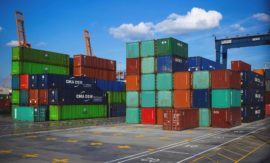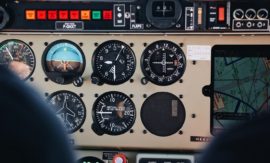Courses and Their Intended Learning Outcomes (ILO)

Course 1 – Logistics, Operations, and Supply Chain Management
Intended learning outcomes: Describe basic definitions, issues, and challenges. Identify business partners and business objects. Explain strategies in the entrepreneurial context. Disclose how performance is measured.

Course 2 – Supply Chain Design: Business Relations and Risks
Intended learning outcomes: Explain concepts such as the make-or-buy decision, tariff-orientation and total cost of ownership in a global supply chain. Differentiate strategic design options for the relationships with and the selection of suppliers. Disclose strategies for intensive cooperation in the supply chain. Describe identification, assessment and handling of supply chain risks.

Course 3 – Supply Chain Design: Location Planning and Sustainability
Intended learning outcomes: Produce design options for global production, distribution, service, and transportation networks. Describe location selection / configuration for a production network using qualitative / quantitative methods. Explain the concept of sustainability with reference to the triple bottom line. Disclose economic opportunities for social and environmental commitment as well as energy management…

Course 4 – Business Process Analysis and Concepts for Planning & Control
Intended learning outcomes: Explain important techniques in business process engineering. Describe characteristic features relevant to planning & control in supply chains. Disclose fundamental concepts in logistics and operations management.

Course 5 – The MRP II / ERP Concept: Business Processes and Methods
Intended learning outcomes: Disclose business processes and tasks in planning & control. Explain in detail master planning or long-term planning, Describe detailed planning and execution.

Course 6 – The Lean / Just-in-Time Concept and Repetitive Manufacturing
Intended learning outcomes: Produce an overview on lean / just-in-time and repetitive manufacturing. Explain the lean / just-in-time concept in detail. Describe the Kanban technique. Identify the cumulative production figures principle. Disclose an implementing procedure and a comparison of techniques.

Course 7 – The Concept for Product Families and One-of-a-Kind Production
Intended learning outcomes: Produce logistics characteristics of a product variety concept. Explain adaptive and generative techniques in detail. Describe the use of generative and adaptive techniques for engineer-to-order. Differentiate various ways of cooperation between R&D and Engineering in ETO Companies.

Course 8 – The Concept for the Process Industry
Intended learning outcomes: Produce characteristics of the process industry. Disclose processor-oriented master and order data management. Explain in detail processor-oriented resource management. Describe special features of long-term planning.

Course 9 – ERP Software and SCM Software
Intended learning outcomes: Describe software used for logistics purposes. Explain contents of logistics software packages. Disclose factors for successful implementation of logistics software.

Course 10 – Demand Planning and Demand Forecasting
Intended learning outcomes: Produce an overview of forecasting techniques. Explain history-oriented techniques for constant demand in detail. Identify history-oriented techniques with trend-shaped behavior. Describe three future-oriented techniques. Disclose how to use forecasts in planning.

Course 11 – Inventory Management and Stochastic Materials Management
Intended learning outcomes: Describe usage statistics, analyses, and classifications. Explain in detail the order point technique. Disclose how to calculate safety stock. Differentiate various batch or lot sizing techniques.

Course 12 – Deterministic Materials Management
Intended learning outcomes: Produce an overview on demand and available inventory along the time axis. Describe deterministic determination of independent demand. Explain in detail the deterministic determination of dependent demand (Material Requirements Planning, MRP). Differentiate various lot sizing techniques. Disclose how to analyze the results of the MRP.

Course 13 – Time Management and Scheduling
Intended learning outcomes: Present the elements of time management. Explain in detail knowledge on buffers and queues. Disclose scheduling of orders and scheduling algorithms. Describe splitting and overlapping.

Course 14 – Capacity Management
Intended learning outcomes: Present fundamentals of capacity management. Explain in detail load profile calculation and infinite loading. Disclose finite loading. Describe rough-cut capacity planning.

Course 15 – Order Release and Control
Intended learning outcomes: Differentiate various techniques for order release. Explain in detail shop floor control. Present methods and techniques used for order monitoring and shop floor data collection. Describe distribution control.

Course 16 – Cost Estimation, Job-Order Costing, and Activity-Based Costing
Intended learning outcomes: Produce a review on costs, cost elements, and cost structures. Explain cost estimation in detail. Describe job-order costing. Disclose activity-based costing.

Course 17 – Representation and System Management of Logistic Objects
Intended learning outcomes: Describe order data in sales, distribution, production, and procurement. Explain in detail master data for products and processes. Disclose extensions arising from the variant-oriented and the processor-oriented concepts. Produce an overview on the management of product and engineering data.

Course 18 – Quality Management — TQM and Six Sigma
Intended learning outcomes: Produce an overview on concept and measurement of quality. Explain quality management tasks at the operations level. Describe quality management systems.

Course 19 – Systems Engineering and Project Management
Intended learning outcomes: Explain systems engineering. Disclose project management.

Course 20 – Selected Sections of Information Management
Intended learning outcomes: Produce a review of important terms in information management. Disclose the modeling of operational information systems. Explain in detail the modeling of information systems in the data view and object view.
